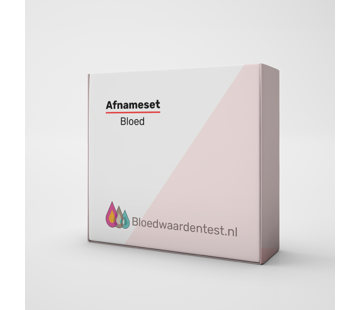Thyroid test with iron status
This thyroid test consists of the blood tests:
- TSH
- Free T4 (FT4)
- Free T3 (FT3)
- Anti-TPO (Thyreoid. microsomal al.)
- Iron
- Ferritin
Thyroid disorders lead to a variety of vague symptoms. With an overactive thyroid, these include: rapid heartbeat, weight loss, nervousness, shaky hands, irritated eyes, sleep problems and feeling agitated. In women, an irregular menstrual cycle may also occur. Thyroid hormone deficiency results in weight gain, dry skin, constipation, feeling cold easily, fatigue and, in women, heavy menstrual bleeding.
TSH (thyroid stimulating hormone).
Ensures that the right amount of thyroid hormone is always produced. Thyroid hormone regulates the use of energy in the body it has a kind of thermostat function.
FT4
Ensures that all kinds of processes in the body run fast enough. Too low a value indicates a thyroid gland that works too slowly. Too high a FT4 indicates a thyroid gland that works too fast.
FT3
Is the hormone created from T4 that causes the final effect of thyroid hormone. So actually, T3 is more important than T4.
FT3 (free T3) and total T3 are two different measurements of the thyroid hormone triiodothyronine (T3) in the blood. the difference is:
* Total T3: This measures the total amount of T3 in the blood, including T3 bound to proteins. About 99% of the T3 in the blood is bound to proteins. Total T3 can be affected by changes in the amount of transport proteins, such as albumin and thyroxine-binding globulin. It can provide some information about total T3 levels in the body, but it may be less accurate in assessing thyroid function.
* FT3 (free T3): This measures the free and biologically active T3 in the blood, which is not bound to proteins. Only about 1% of the T3 in the blood is free T3. The free T3 level is often a better indicator of active thyroid function because it measures the amount of T3 available to body tissues. Generally, FT3 is considered a more reliable test than total T3 in assessing thyroid function.
Anti-TPO (thyroid peroxidase).
This test measures antibodies that target the thyroid gland. Usually, the immune system makes antibodies to render unwanted invaders or pathogens harmless. Sometimes something goes wrong, causing antibodies to be made against healthy cells, tissue or organs in the body. It leads to autoimmune diseases in which unintentional damage and inflammation occurs to body tissues and organs, such as the thyroid gland in this case.
Iron
In organisms, iron plays an important role. The protein hemoglobin owes its activity to iron ions. Iron is also an important component of many enzymes.
Ferritin
Is a protein that provides iron binding during storage in the liver and bone marrow. There is always a small amount of ferritin present in the blood. This is a measure of the amount of ferritin (and thus the amount of iron) in the liver and bone marrow.
Ferritin and iron are two markers that are often measured alongside thyroid function tests to get a more complete picture of overall health status, especially in the areas of anemia and iron deficiency. Here are some reasons why ferritin and iron are measured in relation to thyroid function:
Relationship between thyroid hormones and iron status: Thyroid hormones can affect the absorption, transport and metabolism of iron in the body. A thyroid hormone deficiency (hypothyroidism) can lead to delayed iron metabolism, which can result in lower ferritin and iron levels.
Symptom overlap: Some symptoms of low thyroid function, such as fatigue, weakness and lethargy, may also be seen with iron deficiency and anemia. Therefore, it is important to assess iron status to rule out or identify other possible causes of these symptoms.
Anemia: An imbalance of thyroid hormones can affect red blood cell production, leading to anemia. Iron deficiency is one of the most common causes of anemia. Measuring ferritin and iron helps identify a possible iron deficiency-related anemia, which in turn may indicate underlying thyroid problems.











